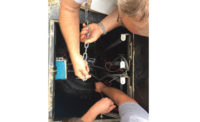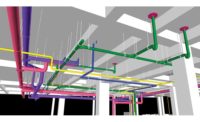The development of software for the plumbing and mechanical engineering and contracting market moves at a rapid pace. Developers are attributing that evolution to the cooperative partnership with engineers and contractors.
“Trimble works with its customers every day for feedback on market trends or special requirements,” says Brett Stacks, a segment manager for MEP solutions at Trimble. “We even have organized regular roundtable discussions with key companies or influential market users even if they currently are not using Trimble’s products.”
Steven Butler, a senior industry strategy manager for MEP for Autodesk, states the company learns a great deal from meetings with industry members.
“Autodesk proactively works with mechanical and plumbing engineers and contractors throughout its development process,” he says. “These activities include inviting customers to attend development-review meetings where they can provide immediate feedback on new feature developments. This also includes new-release testing activities conducted at various locations across the world.”
One of Trimble’s main software programs for MEP engineers and contractors is SysQue, an add-on for Revit. It provides users with the tools to create levels of development (LOD) 400 models based on manufacturer-driven content.
“By providing a Revit-based solution and backing it with millions of manufacturer-based content, engineers and contractors no longer are required to export or convert design models to AutoCAD,” Stacks notes. “It only requires them to later rebuild or redraw the model from scratch.”
Stacks continues: “By staying on Revit and working with native Revit components, a contractor can add detail to the original design model, maintain design information and collaborate more deeply with the engineer as well as other contractors who already are in that platform.”
Also recently, Trimble acquired Building Data, a MEP data-supply service. Stacks believes this and SysQue are a great start to improving project collaboration.
“Trimble wants to expand that collaboration further by enabling better workflow and cooperation between other departments such as estimating, shop fabrication, procurement and the field. While Trimble provides solutions for all these project stages, there is little data shared between them,” he explains.
Butler says it is critical to allow plumbing and mechanical engineers to iterate over design options more easily, as well as more reliably be able to simulate system performance.
“Engineers who have adopted BIM are increasingly looking to achieve more with the model. They are exploring new ways to mine the model and its data and help inform design decisions,” he says. “As such, we are seeing a significant increase in the use of generative and computation design tools, as well as simulation.”
Butler adds: “We also are seeing an increase in the use of augmented reality, virtual reality and mixed reality, both for design and construction, as the technology becomes more capable and robust. As these technologies emerge, the cloud becomes a fundamental part of the process, both in powering their capabilities as well as enabling improved collaborations and communications.”
Autodesk notes its flagship product has improved with calculations for hydronic networks, greater support for complex networks and slopped pipe-modeling enhancements.
“All these help to increase user productivity and improve model accuracy,” Butler says.
Cooperation with manufacturers is of the utmost importance in the development process of both Trimble and Autodesk products.
“Autodesk works with a number of manufacturers in various capacities to support our mutual customers,” Butler says. “Many manufacturers are beginning to provide BIM content and are keen to understand the company’s strategy to ensure alignment.”
Trimble states it has always been involved with manufacturers and previously maintained most of those relationships through its Trade Service organization that supplies pricing information for manufacturer fittings. Building Data also managed its partnerships to make sure dimensional, specification and other manufacturer information was correctly being distributed through its service. With both under the same company umbrella, nothing is expected to change.
“We see this content as key to the success of our clients who need to accurately estimate, model and construct based on this very information,” Stacks says.






